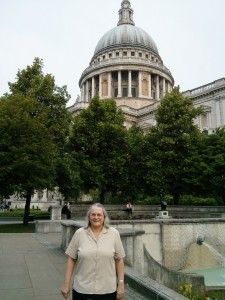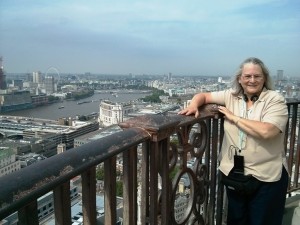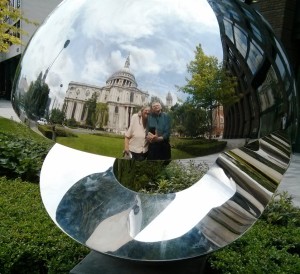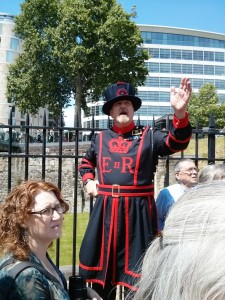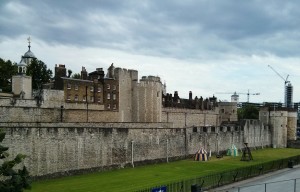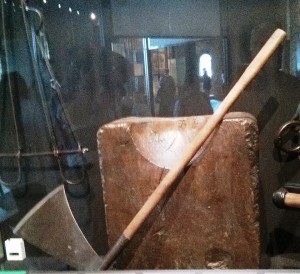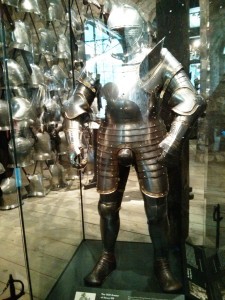Monday, June 9
There was no time for sleeping in today. We were in London with a lot of things to get done. The forecast was for thunderstorms in the afternoon, but the day turned out to be a nice one. There was a brief shower, which occurred after we got back to our room for the night. In fact, we had good to excellent weather every day of our trip in the UK. There were a couple of other cloudy days, and we kept our umbrellas handy on those days, but I never used my umbrella because it never rained while we were outside. Temperatures were a little above normal. Our warmest day was in Edinburgh, where the high was 82 degrees.
Our day was focused on two main attractions — St. Paul’s Cathedral and the Tower of London. Both of these are in old London. Our hotel is on the other side of central London, near Westminster Cathedral. So this was our inaugural visit to this part of town, as well as our inaugural use of the tube.
St. Paul’s Cathedral opened first, so we went there first. This is one of the more recognizable buildings in London. The building was designed by Sir Christopher Wren. It was his seminal work. The dome is the highest and largest (if one applies the correct modifiers). There are actually 2 domes. The outside dome is 365 feet high. We were both surprised how much there was to see. After visiting the main floor, one can walk up three levels.
The first level is the “whispering gallery”, about half way up the inside dome. If you do it right, two people can stand on opposite sides of the dome. A person on one side can hear the other person whispering on the other side. We didn’t do it right, because the only thing we heard was a lot of other people whispering “Can you hear me?” The next level up is the stone gallery, a balcony around the outside of the dome. It is about as high as the inside dome. The third level, some 530 steps from the main floor, goes around the top of the outside dome. Danita and I both made it to the top in good form. The view is exhilarating. After this, we went down to the crypt. Our audio guides had excellent presentations, but we found we weren’t as interested in the crypt, so we moved on to the Tower of London.
All the guide books say one should start the Tower of London with a Beefeater Tour, and they are right. It was a very interesting, entertaining, and informative tour. This guy loved tweaking the Americans. One of his favorite lines was “This is history” (comparing the 900 years of the Tower of London to the 300-year history of the US). Of course, what he didn’t mention is that the written history of London goes back to Roman times. We’ve seen the Roman ruins in Barcelona. That’s history. English archiological history goes back even further to Stonehenge. Danita saw a stone circle from the train on Tuesday (I was napping.) But London doesn’t have any major touring areas from Roman or earlier times.
The Tower of London is the original castle in London, built by William the Conqueror to protect himself from his conquest. (It seems the Saxons didn’t take very kindly to being ruled by a Norman king.) William died before the castle was finished. His son, William II, finished the castle. Succeeding kings used it — it was their official residence for about 500 years. It is unique because the original stones still stand as they were originally built in 1100 (more or less). Most of the exhibits are original items (not reproductions).
The Normans were far advanced of the English. They were using chimneys, which the English wouldn’t start doing for another 100 years. (The English generally built a fire in the middle of the room on the floor.) Not only that, but the Normans used stealth chimneys. Fireplaces had slots on either side of the flue. Smoke was dispersed and discharged such that nobody could see it from outside the castle. Outsiders couldn’t see whether the fireplaces were in use.
After that we wandered around and stumbled into the tour of St. John’s Chapel. (Pictures weren’t allowed because it is still used for worship services.) I’m not sure how far back one has to go before saying “This is history”, but I was quite satisfied to sit in the chapel where William II and his queen celebrated mass.
By this time we were getting our London legs. I was not surprised to find it is quite easy to navigate the tube. London streets are another matter. They go in all different directions. I had a data plan for my phone. I found it’s quite addictive to have instant, full-time access to data. The navigation aid I was counting on most was my phone’s GPS, along with Google Maps. It was useful, but there were issues, especially in London. The GPS got confused with all the signals bouncing off the tall buildings around us. It generally knew where we were, but sometimes was off by one street. Errors were worse with direction. If we were walking north, sometimes the GPS would say we were walking south. Finally, my phone had trouble holding a battery charge all day, so I had to limit my time viewing the map screen. Fortunately, we had an unexpected navigation aid for London streets. In fact, navigating London is amazingly easy, thanks to London’s brilliantly designed “You are here” maps. These are found every few blocks in London’s central district, oriented so that the “you are here” arrow shows exactly where you are and which way you are facing. Just about everything a tourist could want to get to is marked on this map. Each display had two maps, one marking a 5-minute walk and the other a 10-minute walk. These were quite a surprise, because the two tour books I read don’t mention them. I wish they had, because we spent quite a bit of effort looking for how to walk to our next destination, and most of that effort would have been avoided if we had known about these brilliant tourist aids.
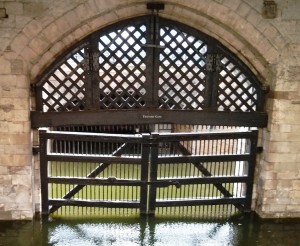
Traitor Gate. This thing is *heavy* Not even Mel Gibson held this up with one hand while fighting with the other.
Our other surprise was the quality of the food. The English are famous for having lousy cuisine. We certainly had some perfectly awful “grab and go” breakfasts and lunches, where sandwiches are made ahead of time, sitting on the shelf. But throughout our visit in the UK, restaurant food was quite good. When we took the time to have a “sit down and order” meal, we were never disappointed. I had Welsh pastry, meat pies, meat Yorkshire pudding, Italian pasta, pizza, etc. It was all good or excellent. We found there weren’t many vegetables. And it helps that we were smart about what we ordered. No “bangers and mash”, no “fish and chips”, and no “haggis”. Coffee was available everywhere we went and it was pretty good to excellent. I even found that tea can be a pleasant drink, if one adds enough milk and sugar.
When we got back to our hotel, we were pretty tired and spent some time watching very bad TV until we could say it was late enough to go to bed.

